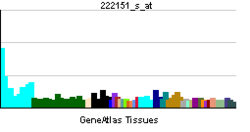CEP63
| Centrosomal protein 63kDa | |||||||||||||
|---|---|---|---|---|---|---|---|---|---|---|---|---|---|
| Identifiers | |||||||||||||
| Symbols | CEP63 ; SCKL6 | ||||||||||||
| External IDs | OMIM: 614724 MGI: 2158560 HomoloGene: 11861 GeneCards: CEP63 Gene | ||||||||||||
| |||||||||||||
| RNA expression pattern | |||||||||||||
 | |||||||||||||
 | |||||||||||||
| More reference expression data | |||||||||||||
| Orthologs | |||||||||||||
| Species | Human | Mouse | |||||||||||
| Entrez | 80254 | 28135 | |||||||||||
| Ensembl | ENSG00000182923 | ENSMUSG00000032534 | |||||||||||
| UniProt | Q96MT8 | Q3UPP8 | |||||||||||
| RefSeq (mRNA) | NM_001042383 | NM_001081122 | |||||||||||
| RefSeq (protein) | NP_001035842 | NP_001074591 | |||||||||||
| Location (UCSC) | Chr 3: 134.49 – 134.58 Mb | Chr 9: 102.59 – 102.63 Mb | |||||||||||
| PubMed search | |||||||||||||
Centrosomal protein of 63 kDa is a protein that in humans is encoded by the CEP63 gene.[1][2] Several alternatively spliced transcript variants have been found, but their biological validity has not been determined.
Function
This gene encodes a protein with six coiled-coil domains. The protein is localized to the centrosome, a non-membraneous organelle that functions as the major microtubule-organizing center in animal cells.[2] Recent computational analysis revealed pathogenic property of L61P point mutation in CEP63 protein that affected its native structural conformation. [3]
Interactions
CEP63 has been shown to interact with DISC1,[4] CEP152 and CDK1.[3]
References
- ↑ Andersen JS, Wilkinson CJ, Mayor T, Mortensen P, Nigg EA, Mann M (Dec 2003). "Proteomic characterization of the human centrosome by protein correlation profiling". Nature 426 (6966): 570–4. doi:10.1038/nature02166. PMID 14654843.
- ↑ 2.0 2.1 "Entrez Gene: CEP63 centrosomal protein 63kDa".
- ↑ 3.0 3.1 Kumar A, Purohit R (April 2012). "Computational investigation of pathogenic nsSNPs in CEP63 protein". Gene 503 (1): 75–82. doi:10.1016/j.gene.2012.04.032. PMID 22555018.
- ↑ Morris JA, Kandpal G, Ma L, Austin CP (July 2003). "DISC1 (Disrupted-In-Schizophrenia 1) is a centrosome-associated protein that interacts with MAP1A, MIPT3, ATF4/5 and NUDEL: regulation and loss of interaction with mutation". Hum. Mol. Genet. 12 (13): 1591–608. doi:10.1093/hmg/ddg162. PMID 12812986.
Further reading
- Harrington JJ, Sherf B, Rundlett S, Jackson PD, Perry R, Cain S et al. (2001). "Creation of genome-wide protein expression libraries using random activation of gene expression". Nat. Biotechnol. 19 (5): 440–5. doi:10.1038/88107. PMID 11329013.
- Morris JA, Kandpal G, Ma L, Austin CP (2003). "DISC1 (Disrupted-In-Schizophrenia 1) is a centrosome-associated protein that interacts with MAP1A, MIPT3, ATF4/5 and NUDEL: regulation and loss of interaction with mutation". Hum. Mol. Genet. 12 (13): 1591–608. doi:10.1093/hmg/ddg162. PMID 12812986.
- Rual JF, Venkatesan K, Hao T, Hirozane-Kishikawa T, Dricot A, Li N et al. (2005). "Towards a proteome-scale map of the human protein-protein interaction network". Nature 437 (7062): 1173–8. doi:10.1038/nature04209. PMID 16189514.
- Kimura K, Wakamatsu A, Suzuki Y, Ota T, Nishikawa T, Yamashita R et al. (2006). "Diversification of transcriptional modulation: large-scale identification and characterization of putative alternative promoters of human genes". Genome Res. 16 (1): 55–65. doi:10.1101/gr.4039406. PMC 1356129. PMID 16344560.
- Buim ME, Soares FA, Sarkis AS, Nagai MA (2005). "The transcripts of SFRP1,CEP63 and EIF4G2 genes are frequently downregulated in transitional cell carcinomas of the bladder". Oncology 69 (6): 445–54. doi:10.1159/000090984. PMID 16410684.
| ||||||||||||||||||||||||||||